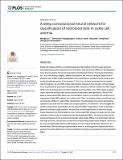| dc.contributor.author | Xu, Mengjia | |
| dc.contributor.author | Zhao, Hong | |
| dc.contributor.author | Karniadakis, George Em | |
| dc.contributor.author | Papageorgiou, Dimitrios P. | |
| dc.contributor.author | Abidi, Sabia | |
| dc.contributor.author | Dao, Ming | |
| dc.date.accessioned | 2018-01-19T14:57:23Z | |
| dc.date.available | 2018-01-19T14:57:23Z | |
| dc.date.issued | 2017-10 | |
| dc.date.submitted | 2017-05 | |
| dc.identifier.issn | 1553-7358 | |
| dc.identifier.uri | http://hdl.handle.net/1721.1/113229 | |
| dc.description.abstract | Sickle cell disease (SCD) is a hematological disorder leading to blood vessel occlusion accompanied by painful episodes and even death. Red blood cells (RBCs) of SCD patients have diverse shapes that reveal important biomechanical and bio-rheological characteristics, e.g. their density, fragility, adhesive properties, etc. Hence, having an objective and effective way of RBC shape quantification and classification will lead to better insights and event ual better prognosis of the disease. To this end, we have developed an automated, high-throughput, ex-vivo RBC shape classification framework that consists of three stages. First, we present an automatic hierarchical RBC extraction method to detect the RBC region (ROI) from the background, and then separate touching RBCs in the ROI images by applying an improved random walk method based on automatic seed generation. Second, we apply a mask-based RBC patch-size normalization method to normalize the variant size of segmented single RBC patches into uniform size. Third, we employ deep convolutional neural networks (CNNs) to realize RBC classification; the alternating convolution and pooling operations can deal with non-linear and complex patterns. Furthermore, we investigate the specific shape factor quantification for the classified RBC image data in order to develop a general multiscale shape analysis. We perform several experiments on raw microscopy image datasets from 8 SCD patients (over 7,000 single RBC images) through a 5-fold cross validation method both for oxygenated and deoxygenated RBCs. We demonstrate that the proposed framework can successfully classify sickle shape RBCs in an automated manner with high accuracy, and we also provide the corresponding shape factor analysis, which can be used synergistically with the CNN analysis for more robust predictions. Moreover, the trained deep CNN exhibits good performance even for a deoxygenated dataset and distinguishes the subtle differences in texture alteration inside the oxygenated and deoxygenated RBCs. | en_US |
| dc.description.sponsorship | National Institutes of Health (U.S.) (Grant U01HL114476) | en_US |
| dc.description.sponsorship | National Institutes of Health (U.S.) (Grant R01HL121386) | en_US |
| dc.publisher | Public Library of Science | en_US |
| dc.relation.isversionof | http://dx.doi.org/10.1371/journal.pcbi.1005746 | en_US |
| dc.rights | Creative Commons Attribution 4.0 International License | en_US |
| dc.rights.uri | http://creativecommons.org/licenses/by/4.0/ | en_US |
| dc.source | PLoS | en_US |
| dc.title | A deep convolutional neural network for classification of red blood cells in sickle cell anemia | en_US |
| dc.type | Article | en_US |
| dc.identifier.citation | Xu, Mengjia et al. “A Deep Convolutional Neural Network for Classification of Red Blood Cells in Sickle Cell Anemia.” Edited by Qing Nie. PLOS Computational Biology 13, 10 (October 2017): e1005746 © 2017 Xu et al | en_US |
| dc.contributor.department | Massachusetts Institute of Technology. Center for Materials Science and Engineering | en_US |
| dc.contributor.mitauthor | Papageorgiou, Dimitrios P. | |
| dc.contributor.mitauthor | Abidi, Sabia | |
| dc.contributor.mitauthor | Dao, Ming | |
| dc.relation.journal | PLOS Computational Biology | en_US |
| dc.type.uri | http://purl.org/eprint/type/JournalArticle | en_US |
| eprint.status | http://purl.org/eprint/status/PeerReviewed | en_US |
| dc.date.updated | 2018-01-19T14:07:13Z | |
| dspace.orderedauthors | Xu, Mengjia; Papageorgiou, Dimitrios P.; Abidi, Sabia Z.; Dao, Ming; Zhao, Hong; Karniadakis, George Em | en_US |
| dspace.embargo.terms | N | en_US |
| dc.identifier.orcid | https://orcid.org/0000-0003-2678-4491 | |
| dc.identifier.orcid | https://orcid.org/0000-0002-7508-4320 | |
| mit.license | PUBLISHER_CC | en_US |
